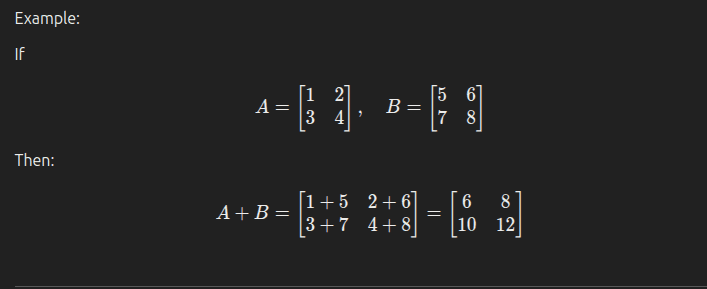- Published on
- •2 min read
Understanding Matrices: Solving Complex Problems in the Real World
- Authors

- Name
- Pulathisi Kariyawasam
- @RandhanaK
Introduction to Matrices
Matrices are rectangular arrays of numbers, symbols, or expressions, arranged in rows and columns. They are fundamental tools in mathematics, providing a concise way to represent and manipulate data. The historical development of matrices dates back to ancient civilizations, but they gained prominence in the 19th century with the work of mathematicians like Arthur Cayley and James Sylvester.
Matrices are essential in various fields, including physics, engineering, computer science, and economics, due to their ability to simplify complex calculations and represent multi-dimensional data.
Understanding Matrix Operations
Addition and Subtraction
Matrix addition and subtraction involve combining two matrices of the same dimensions by adding or subtracting their corresponding elements. For example:

Matrix Multiplication
Matrix multiplication is more complex and involves the dot product of rows and columns. For two matrices A (of size m × n) and B (of size n × p), the resulting matrix C (of size m × p) is computed as follows:

Determinants and Inverse Matrices
The determinant of a square matrix is a scalar value that helps determine whether the matrix is invertible.
 where I is the identity matrix.
where I is the identity matrix.Real-World Applications
Computer Graphics and 3D Transformations
Matrices are crucial in computer graphics for transforming shapes and images. They enable operations like rotation, scaling, and translation of 3D objects.
Machine Learning and Neural Networks
In machine learning, matrices are used to represent datasets and perform operations in neural networks, such as weight adjustments during training.
Digital Image Processing
Images can be represented as matrices, where each element corresponds to a pixel's intensity. Matrix operations facilitate filtering, transformations, and enhancements.
Economics and Finance (Input-Output Models)
Matrices are employed in economics to model the relationships between different sectors, helping to analyze the flow of goods and services.
Quantum Mechanics
In quantum mechanics, state vectors and operators are represented as matrices, allowing for the mathematical formulation of physical phenomena.
Search Engines and PageRank Algorithm
Google’s PageRank algorithm uses matrices to rank web pages based on their link structures, analyzing the connectivity of the web.
Engineering (Structural Analysis)
Matrices are utilized in engineering to analyze forces and stresses in structures, aiding in the design and safety assessments.
Problem-Solving with Matrices
Linear Systems of Equations
Matrices provide a systematic way to solve linear equations using techniques like Gaussian elimination or matrix inversion.
Network Analysis
In network theory, matrices represent connections and flows, enabling the analysis of social networks, transportation systems, and more.
Optimization Problems
Matrices are integral in optimization problems, particularly in linear programming, where they help define constraints and objectives.
Data Compression
Matrix transformations, such as Singular Value Decomposition (SVD), are used in data compression techniques, reducing storage requirements while preserving essential information.
Error Correction Codes
Matrices play a vital role in coding theory, particularly in designing error correction codes that ensure data integrity during transmission.
Matrices in Modern Technology
Computer Vision
Matrices are at the core of computer vision algorithms, enabling machines to interpret and analyze visual data.
Facial Recognition
Facial recognition systems use matrices to process and compare facial features, enhancing security and user identification.
Recommendation Systems
Matrix factorization techniques are employed in recommendation systems, such as those used by Netflix and Amazon, to suggest content based on user preferences.
Game Development
In game development, matrices are used for physics simulations, rendering graphics, and managing object transformations.
Scientific Simulations
Matrices enable scientists to model complex systems and simulate real-world phenomena, from climate models to molecular dynamics.
Benefits and Advantages
Efficient Data Organization
Matrices allow for structured data representation, making it easier to manipulate and analyze large datasets.
Parallel Processing
Matrix operations can be parallelized, significantly speeding up computations in high-performance computing environments.
Complex Calculations Simplification
Matrices simplify complex calculations, allowing for more efficient problem-solving in various applications.
Pattern Recognition
Matrices facilitate pattern recognition in data analysis, enabling the identification of trends and anomalies.
System Modeling
Matrices provide a framework for modeling real-world systems mathematically, aiding in predictions and analyses.
Future Perspectives
Emerging Applications
As technology evolves, matrices are finding new applications in fields like bioinformatics, robotics, and smart cities.
Role in Quantum Computing
Matrices are essential in quantum computing, providing the mathematical foundation for quantum algorithms and operations.
Advanced AI Applications
With the rise of advanced AI, matrices will play a critical role in developing more sophisticated models and algorithms.
New Mathematical Developments
Research in matrix theory continues to advance, leading to new techniques and applications in various scientific disciplines.
Practical Examples and Case Studies
Google's PageRank Implementation
Google's PageRank algorithm uses matrices to analyze the web's link structure, ranking pages based on their importance and relevance.
Netflix Recommendation System
Netflix employs matrix factorization to analyze user preferences and suggest content tailored to individual tastes.
Computer Animation in Pixar Movies
Pixar uses matrices to perform complex transformations and animations, bringing characters and scenes to life.
Engineering Structure Analysis
Engineers use matrices to analyze and design structures, ensuring safety and stability in buildings and bridges.
Conclusion
Matrices are powerful mathematical tools that help solve complex problems across various fields. Their applications in technology, science, and everyday life demonstrate their significance in modern society. As we continue to explore new frontiers, the role of matrices will only grow, paving the way for innovative solutions and advancements.